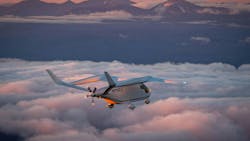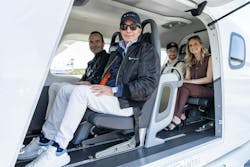Electric Passenger Aircraft Poised for Production After 28-State “Barnstorming” Tour
What you’ll learn:
- Real-world tests of BETA Technologies’ production-ready electric commuter aircraft have shown it can carry six people at 150+mph across distances of over 350 miles.
- The CX300 can fly these missions using $20 worth of electricity at a fraction of the cost and carbon footprint of operating an equivalent conventional aircraft.
- Following a successful 8,000-mile series of demonstration flights across 28 states, BETA anticipates it can begin deliveries to customers by the end of 2025.
UFO enthusiasts were disappointed to learn that recent sightings of strange-looking aircraft throughout the U.S. and Europe were found to be of terrestrial origin. Nonetheless, many others are hopeful that a bold multi-continent odyssey undertaken by an electric passenger liner may offer a glimpse into the future of aviation.
The sightings began in late 2024 after BETA Technologies rolled out the first production version of its CX300, a five-passenger electric commuter aircraft and undertook an ambitious demonstration tour across 28 states and several European countries.
Powered by a single 300-kW electric motor (400 kW max), mounted in a “pusher” configuration, it can carry 1250 lbs of people and cargo at speeds approaching 170 mph. When loaded below its maximum rating and flown at slightly lower speeds, the craft has flown up to 386 miles on a single charge.
In its present configuration as a conventional takeoff and landing (CTOL) vehicle, it operates from virtually any municipal airport and even some shorter grass strips, making it well-qualified for both air taxi and local cargo services.
By eliminating expensive, thirsty internal combustion engines, the CX300 costs much less to operate, consuming around $20 worth of electricity versus over $300 worth of gas or kerosene needed to power an equivalent craft, such as a Cessna 208.
Since the first production CX300 made it first test flight in late 2024, it’s undergone thousands of hours of testing, evaluation, and characterization under real-world conditions in preparation for FAA certification, which could occur as early as the end of 2025 or the beginning of 2026.
These activities included a 25-state, 80-airport barnstorming tour of the United States and a “Grand European Tour” across France, England, and Ireland before delivering it to its customer Bristow Group in Norway. Bristow Group already placed a firm order for the company’s electric vertical takeoff and landing (eVTOL) variant back in 2022.
It’s a prototype of the CX250, a variant equipped with four vertical lift rotors to perform vertical takeoffs and landings. It’s also already undergone demonstration flights, and is going through careful exploration of its systems and flight characteristics that are expected to lead to production certification in 2026 or 2027.
Next in This Edition of PowerBites
More PowerBites
About the Author
Lee Goldberg
Contributing Editor
Lee Goldberg is a self-identified “Recovering Engineer,” Maker/Hacker, Green-Tech Maven, Aviator, Gadfly, and Geek Dad. He spent the first 18 years of his career helping design microprocessors, embedded systems, renewable energy applications, and the occasional interplanetary spacecraft. After trading his ‘scope and soldering iron for a keyboard and a second career as a tech journalist, he’s spent the next two decades at several print and online engineering publications.
Lee’s current focus is power electronics, especially the technologies involved with energy efficiency, energy management, and renewable energy. This dovetails with his coverage of sustainable technologies and various environmental and social issues within the engineering community that he began in 1996. Lee also covers 3D printers, open-source hardware, and other Maker/Hacker technologies.
Lee holds a BSEE in Electrical Engineering from Thomas Edison College, and participated in a colloquium on technology, society, and the environment at Goddard College’s Institute for Social Ecology. His book, “Green Electronics/Green Bottom Line - A Commonsense Guide To Environmentally Responsible Engineering and Management,” was published by Newnes Press.
Lee, his wife Catherine, and his daughter Anwyn currently reside in the outskirts of Princeton N.J., where they masquerade as a typical suburban family.
Lee also writes the regular PowerBites series.






